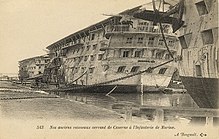Barracks ship
It has been suggested that Yard Repair Berthing and Messing be merged into this article. (Discuss) Proposed since February 2022. |

A barracks ship or barracks barge or berthing barge, or in civilian use accommodation vessel or accommodation ship, is a ship or a non-self-propelled barge containing a superstructure of a type suitable for use as a temporary barracks for sailors or other military personnel. A barracks ship, a military form of a dormitory ship, may also be used as a receiving unit for sailors who need temporary residence prior to being assigned to their ship. The United States Navy classes them as either Auxiliary Personnel Barracks (APB) or Auxiliary Personnel Lighter (aka barge) (APL).
Early use[]




Barrack ships were common during the era of sailing ships when shore facilities were scarce or non-existent. Barrack ships were usually hulks. At times, barrack ships were also used as prison ships for convicts, prisoners of war or civilian internees.
Use in World War II[]
Barracks ships in the combat area provided necessary residence for sailors and merchantmen whose ship had been sunk, or whose ship had been so damaged that on-board berthing was no longer possible. They were also used at advanced bases, and as mobile barracks for units such as construction battalions. Occasionally, they would be used for other roles such as providing office space.
APL were non-self-propelled barracks ships were used by the United States Navy in forward areas during World War II, especially in the Pacific Ocean, and were designated APL, such as APL-18 which was commissioned in 1944 and had the following specifications for APL-1 to APL-58:
- Displacement 1,300 t.(lt), 2,580 t.(fl)
- Length 261 ft (80 m)
- Beam 49 ft (15 m)
- Draft 11 ft (3.4 m)
- Complement unknown
- Accommodations 5 Officers, 358 Enlisted
APB-35 to APB-51 were propelled barracks ships built in 1944. APB had a full load displacement of 2,190 tons.
Transport ships were also used as barracks by other war-time navies, such as the Kriegsmarine's SS General San Martin. One of the two abortive Jade class auxiliary aircraft carriers (Elbe) was also converted into a barracks ship.
Subsequent use[]
The United Kingdom used barracks ships to help garrison the Falkland Islands after it ousted the Argentinian occupation force in the 1982 Falklands War. The former car ferries and TEV Rangatira were deployed to Port Stanley in 1982, and Rangatira stayed until September 1983.[1]
Rangatira is also an example of a civilian accommodation ship. She and another former ferry, MV Odysseus, housed workers who built an oil platform in Loch Kishorn in Scotland in 1977–1978, and Rangatira housed workers who built Sullom Voe Terminal in the Shetland Islands in 1978–1981.[1]
Post World War II USN use[]
Since World War II the USN has used berthing barges, known as Auxiliary Personnel Lighters (APL)[2], to temporarily house personnel off ships. The 70 ships are assigned to the Naval Sea Systems Command (NAVSEA) to bases around the world (Norfolk and Portsmouth, Virginia; San Diego; Bremerton, Washington ; Mayport, Florida; Pearl Harbor, Hawaii; Yokosuka and Sasebo in Japan; and Guam).
APL 65 class[]
The United States Navy placed a contract for two APL 65 berthing barges in August 1998 which were delivered to the Navy in November and December 2000. The APL 65 berthing barges include post office, barber shop, bank, classrooms, laundry, medical facilities and a fitness services.[3]
APL 67 class[]
The older berthing barges are being replaced by five newer ships of the APL 67 class which are being purpose built by VT Halter Marine.[3][4] The first contract was awarded in September 2018 with APL 67 launched in June 2020 and delivered to the USN in August 2021 followed by APL 68 which was delivered in November 2021.[5][6]
- Displacement: 2,744 t
- Length: 269 ft (82 m)
- Beam 69 ft (21 m)
- Draft 16 ft (4.9 m)
- Complement: unknown
- Accommodations: 600 (5 Officers, 358 Enlisted)
References[]
- ^ a b Castell, Marcus (2003–2005). "The Turbo Electric Vessel Rangatira of 1971". The New Zealand Maritime Record. Retrieved 29 May 2013.
- ^ "The Navy has a floating barracks that is somehow worse than living on an actual ship". Task & Purpose. 2021-07-26. Retrieved 2022-02-04.
- ^ a b "Navy to Replace 70-Year-Old Berthing Barges". www.nationaldefensemagazine.org. Retrieved 2022-02-04.
- ^ "APL 67 Sails Away From Pascagoula". Naval Sea Systems Command. Retrieved 2022-02-04.
- ^ "APL 67". Naval Vessel Register. Retrieved 4 February 2022.
{{cite web}}: CS1 maint: url-status (link) - ^ "APL 68". Naval Vessel Register. Retrieved 4 February 2022.
{{cite web}}: CS1 maint: url-status (link)
- This article incorporates text from the public domain Dictionary of American Naval Fighting Ships.
External links[]
- Ship types
- Naval ships
- Auxiliary ship classes